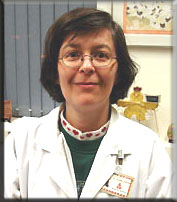|
|
|
Roseline Godbout , Ph.D. |
|
B.Sc. (University of New
Brunswick)
Ph.D. (Department of Medical Biophysics, University of Toronto)
Post-doctoral fellowship (Fox Chase Cancer Center, Philadelphia, PA
and Princeton University, NJ)
Professor, Department of Oncology
Adjunct Professor, Departments of Biochemistry and Ophthalmology
Mailing
Address & Phone/FAX/E-Mail numbers
Dr. Roseline Godbout
Department of Oncology
University of Alberta
11560 University Avenue
Edmonton, Alberta, T6G 1Z2
office phone: (780)-432-8901
office fax: (780)-432-8892
For more information, please contact: rgodbout@ualberta.ca
or
roseline.godbout@ahs.ca |
|
 |
|
|
Research Interest
Summary
Regulation of gene expression in the
developing retina and in retinoblastoma Characterization of glial differentiation genes in brain tumours
|
|
Research Focus |
|
My research group has a number of
interests involving cancer, developmental biology,
biochemistry, cell biology and molecular biology. A major
focus of the lab is to understand how genes expressed at
specific stages of retinal development are regulated.
Towards this end, we are characterizing genes whose
expression profiles suggest a role in the commitment and
differentiation of retinal precursor cells. Using the
chick retina as our model system, we are carrying out
chromatin immunoprecipitation (ChIP) and in ovo
electroporation experiments to understand the role that
the transcription factor AP-2 plays in retinal
differentiation.
Another focus of the lab is to understand how
retinoblastoma, a childhood tumour of the retina, differs
from normal retinal cells. Using a differential screening
approach, we have identified a novel member of the DEAD
box protein family, called ‘DEAD box 1’ or DDX1. DDX1 is
believed to unwind double-stranded RNA and to play a role
in the processing of RNAs. We have discovered that DDX1
is amplified and over-expressed in retinoblastoma as well
as in another childhood tumour called neuroblastoma. We
propose that over-expression of DDX1 in these tumours
provides a growth advantage. We are using DNA
transfections, confocal microscopy, transgenic mice and
biochemical assays to determine the function of DDX1 in
both normal and cancer cells.
A third focus of the lab is to identify and characterize
glial differentiation genes that are expressed in brain
tumours called malignant gliomas. We have discovered that
brain fatty acid-binding protein (B-FABP), a marker of
radial glial differentiation, is co-expressed with glial
fibrillary acidic protein (GFAP), another marker of glial
cell differentiation, in malignant glioma tumour cells.
Our goals are to determine how the expression of glial
cell differentiation markers (e.g. B-FABP and GFAP) is
regulated in malignant glioma tumour cells and to study
the function of these genes in malignant glioma cells. We
believe that a better understanding of these glial
differentiation genes will provide insight into how to
treat malignant glioma tumours, by inducing their
terminal differentiation. We are using microchip cDNA
arrays, cell invasion and motility assays, transformation
assays, as well as a variety of assays related to the
regulation of gene expression, to understand how the
expression of glial genes affects the growth properties
of malignant glioma cells.
|
|
|
Research Funding
Funded by grants from the Canadian
Institutes of Health Research (CIHR), the National Cancer
Institute of Canada (NCIC) and Alberta Cancer Board –
Research Initiative Program (ACB-RIP). |
|
Research Training
Opportunities
Opportunities for research training are available for
graduate students, post-doctoral fellows and summer students.
|
|
|
|
|
|
|
|
| |
|

